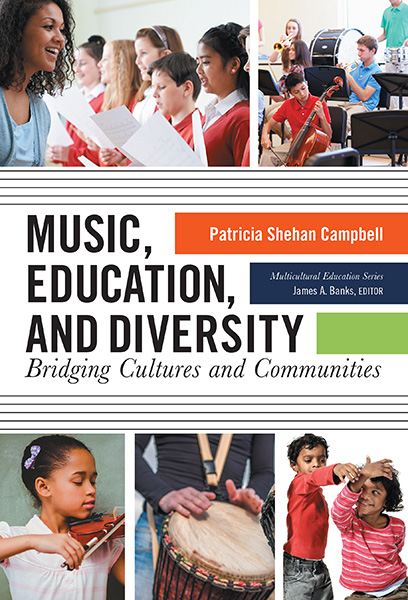Professors: Request an Exam Copy
Print copies available for US orders only. For orders outside the US, see our international distributors.
Publication Date: January 19, 2018
Pages: 240
Series: Multicultural Education Series

Music is a powerful means for educating citizens in a multicultural society and meeting many challenges shared by teachers across all subjects and grade levels. By celebrating heritage and promoting intercultural understandings, music can break down barriers among various ethnic, racial, cultural, and language groups within elementary and secondary schools.
This book provides important insights for educators in music, the arts, and other subjects on the role that music can play in the curriculum as a powerful bridge to cultural understanding. The author documents key ideas and practices that have influenced current music education, particularly through efforts of ethnomusicologists in collaboration with educators, and examines some of the promises and pitfalls in shaping multicultural education through music. The text highlights World Music Pedagogy as a gateway to studying other cultures as well as the importance of including local music and musicians in the classroom.
Book Features:
Patricia Shehan Campbell is the Donald E. Petersen Professor of Music at the School of Music, University of Washington.
"For Campbell, connecting music to engagement, cultural understanding, humankind, teaching, and learning is emphasized again and again throughout the text as the way to bring us together in a peaceful world. Her consistency across the entire set of movements allows her to easily elaborate her argument that music is everywhere and meant for everyone. It clearly is her paradigm."
—TC Record
"Music can be a powerful bridge to cultural understanding, and this book addresses a variety of philosophical and practical topics related to the wide-ranging spectrum"...those that take the time to read this slender volume...will gain insight into issues of diversity and music education from one of the leading thinkers of our time."
—The Kodalay Envoy
“This book clearly articulates the role that music has played and continues to play in the context of the goals and aims of multicultural education, and it also emphasizes areas of curricular intersection between the fields of Ethnomusicology and Music Education. In addition, this book effectively makes the case that any effort to understand ourselves and others as cultural beings cannot be complete without consideration of the nature of the expressive forms (in this case music) that are part and parcel of cultural identity.”
—Constance L. McKoy, The University of North Carolina at Greensboro
"This brilliant, passionate, and personal book describes the history of U.S. music education and argues strongly for the need to include diverse musical traditions in our classrooms and in our lives. Campbell’s reflections on her experiences offer us a valuable and articulate argument on the importance of musical diversity."
—Anthony Seeger, distinguished professor emeritus, UCLA
"Dr. Campbell has devoted her entire career to a deeper understanding of how the music we teach might better represent the many cultures in our classroom. This book represents a culmination of that work, providing a rich context for understanding how music can and should play a central role in the pursuit of a more diverse, culturally relevant education for our children."
—Steven M. Demorest, Northwestern University
“Few educators can match Patricia Campbell’s dedication to learning from the world through her travels, where she works with musicians in Africa, the Americas, Asia, and Europe. In this book the breadth of her experience is translated into cultural understandings of musical diversity, including the importance of engaging with musical communities and culture-bearers, and envisioning music as social justice and vital to human well-being.”
—Keith Howard, SOAS, University of London
“This is a must-read for all teachers engaged in the musical education of children and youth.”
—Marie McCarthy, University of Michigan
Series Foreword by James A. Banks
Prelude: Powering Cultural Understanding Through Music
Chapter 1. Musical Engagement as Human Need
Defining Music
Musicking as a Process
Understanding Musical Diversity
Music’s Impact
Living Musical-Cultural Experience
Music in Education
Music as a Bridge
Chapter 2. The Changing Nature of School Music
Profiling Diversity
Early American-Style Music Learning
A Songful Start with a European Twist
Sealing the Legacy of European Music
Forbidden "Folk" Music
Far and Away Songs
A Latin American Awareness through Music
Music for World Peace and Civic Responsibility
University Studies of World Music Cultures
All-Inclusive Music Education
Continuing Commitments to Music, Education and Diversity
Principles in the Practice of Musical Diversity
Chapter 3. Educational Intersections of Ethnomusicological Ideals
Soft Boundaries and Border-Crossings
Intersections at the University Level
Serving Inservice Teachers
Cross-over Scholarship
Publications "Under the Influence" and "In collaboration"
Shared Concepts between the Fields
Future Intersections
Chapter 4. Multicultural Education and Social Justice in School Music Practice
Shared Tenets
Ensuring Equity through Multicultural Education
Aims and Accomplishments of Multicultural Music Education
Social Justice and Education
Social Justice and Music Education
Connections between Multiculturalism and Social Justice
Banks’s Dimensions of Multicultural Education
Banks’s Four Levels of Curriculum Reform
Applications: Multicultural Social Action and Social Justice in Music Education
The Way Forward
Chapter 5. Transmission, Teaching, and Learning
Studies in Transmission
The Range of Music Learning
Orality and Literacy in Music Education Practice
Cross-cultural Cases of Music, Taught and Learned
Through Listening to Learning
Chapter 6. World Music Pedagogy as Learning Pathway
Music in a Multicultural Way
Defining World Music Pedagogy
Phases of World Music Pedagogy
WMP Exemplar Sequences
Many Music-Culture Splendors for Curricular Practice
Chapter 7. Connections with Culture-Bearers and Communities
The Concept of Community
Musical Communities
Communities of Music-Educational Practice
Growing Up in Four Musical Communities
Culture-bearers
Sound-Bytes and Video-Views of Community Artists
Visiting Artists in University-Community Collaboration
Capital CM, as in Community Music
Applied Ethnomusicology
Field Trip! Excursions to a Community
Community: Bottoms Up
Chapter 8. Principles of Diversity into School Music Practice
Teachers, Trajectories, and Blueprints
Points of Practical Wisdom
Tackling Tenacious Topics
Treasuring the Teacher
Cadenza: Diversifying Music Education
Diversity and Inclusion
Pathways of Progress
References
Index
Professors: Request an Exam Copy
Print copies available for US orders only. For orders outside the US, see our international distributors.